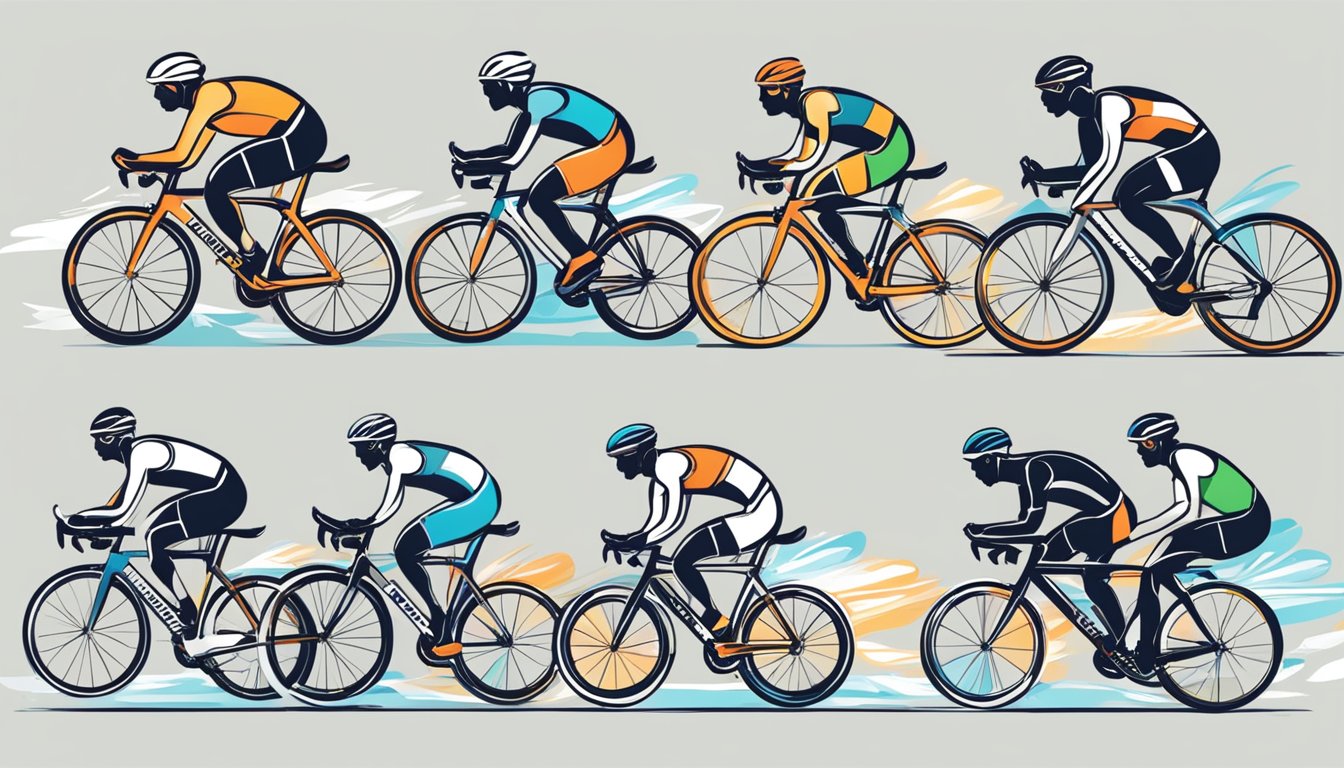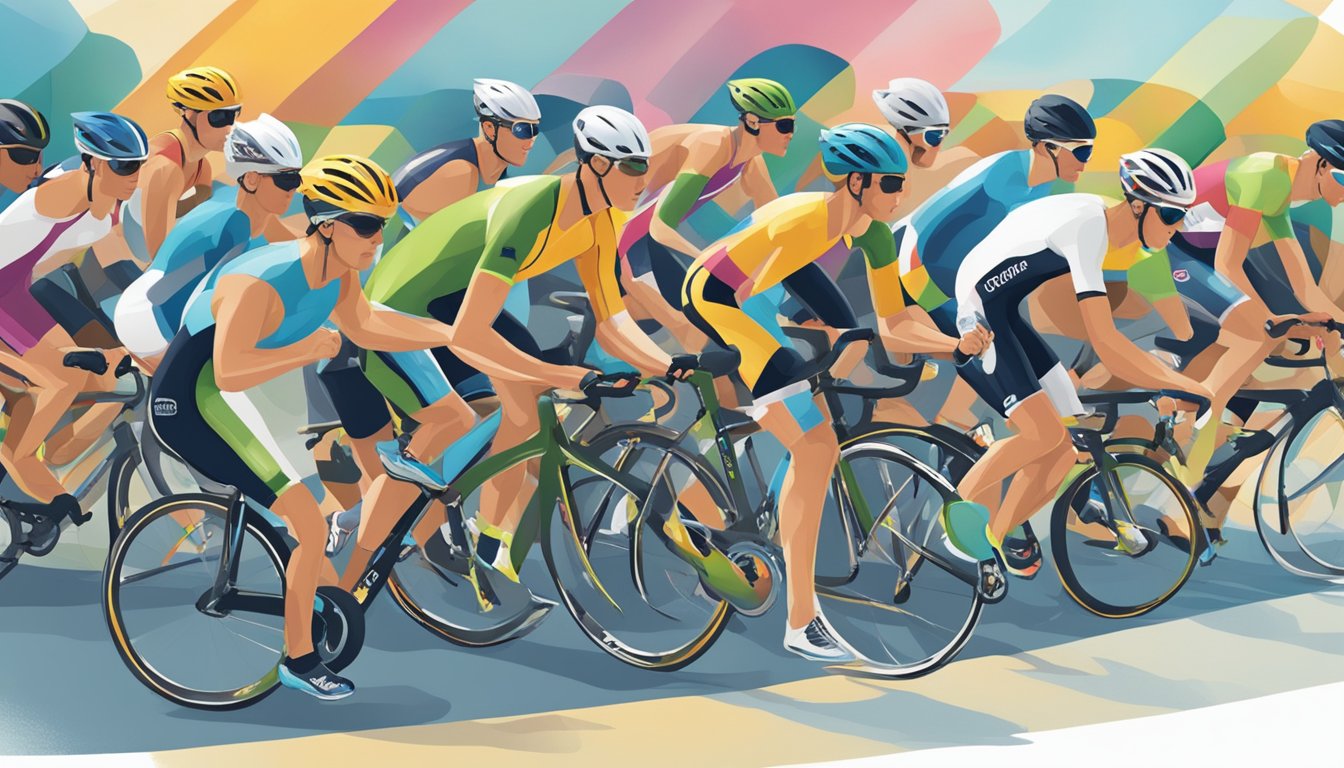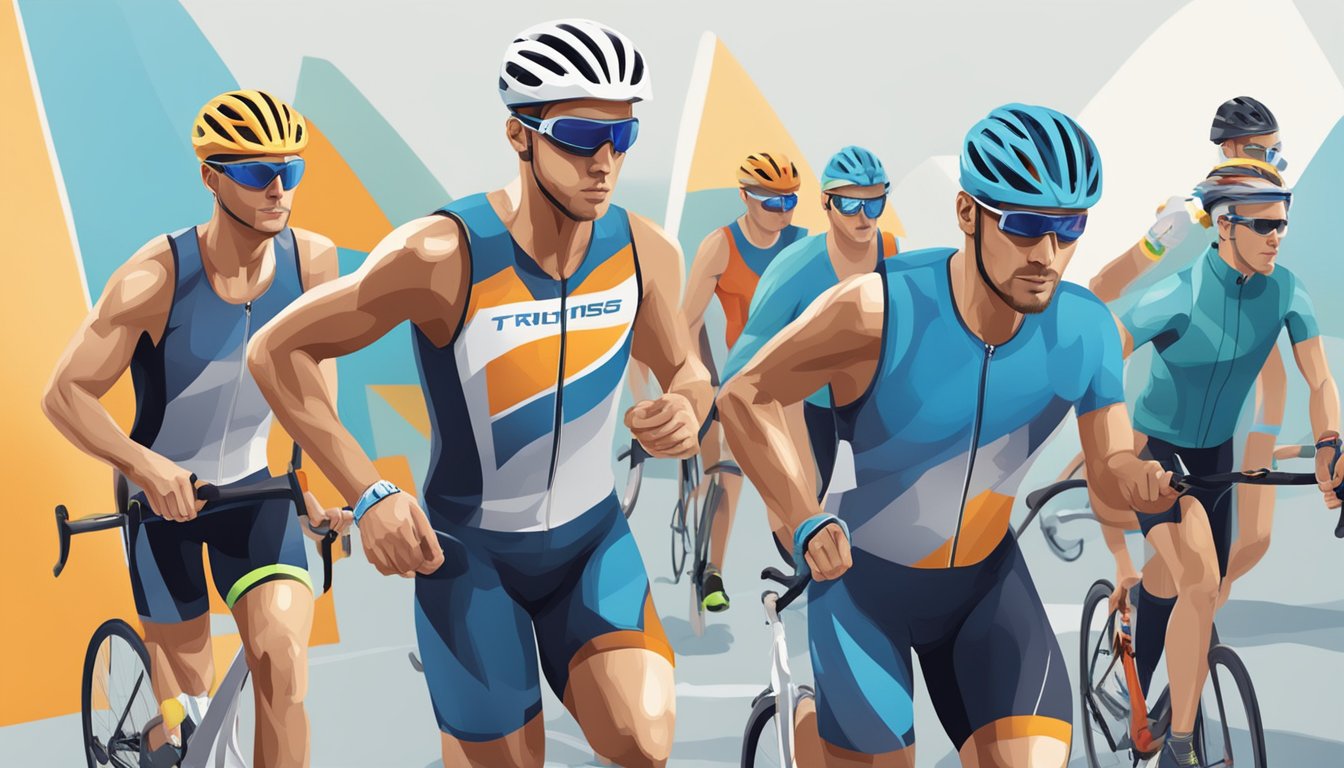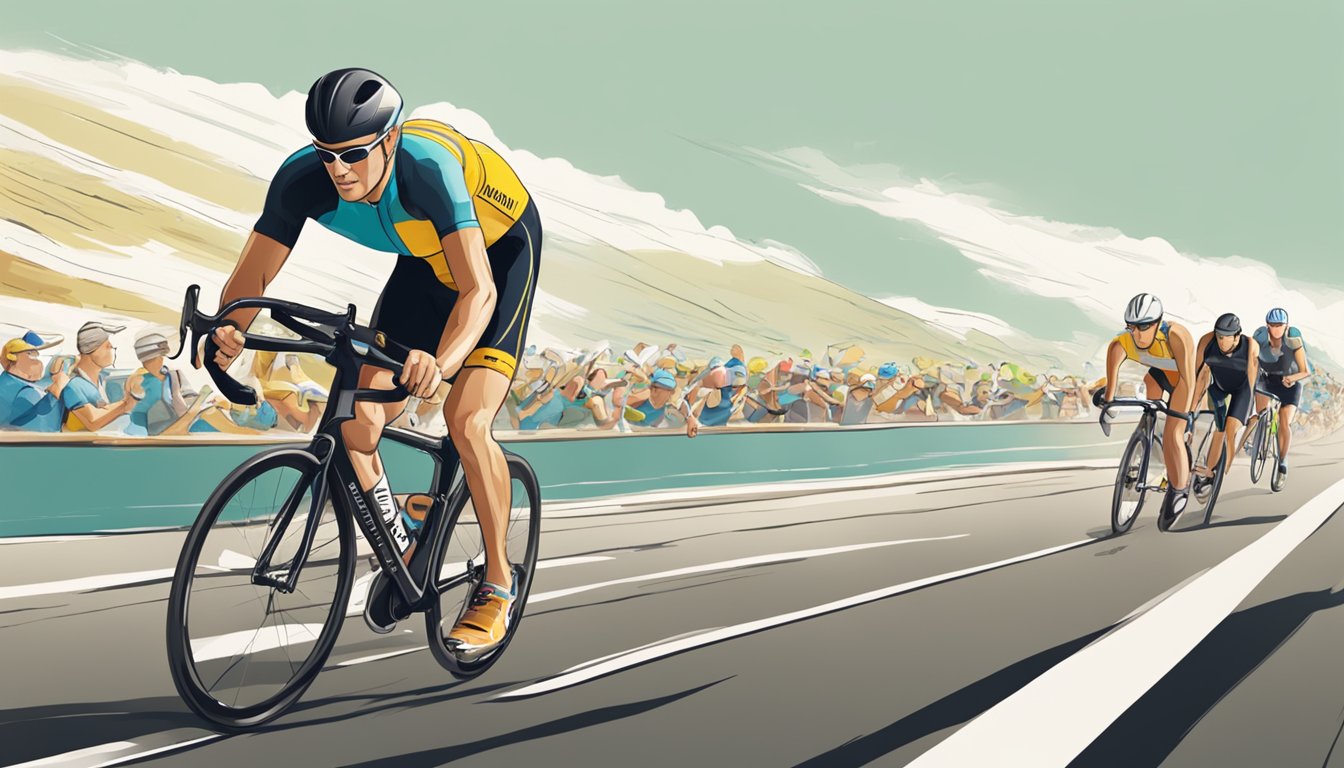If you’re a runner, you may be wondering whether you should try a triathlon or stick to running marathons. While both sports involve endurance and require a lot of training, there are some key differences between them. In this article, we’ll break down the differences between triathlons and marathons to help you decide which sport is right for you.

First, let’s define the two sports. A marathon is a running race that covers a distance of 26.2 miles. It’s a test of endurance that requires months of training to prepare for. A triathlon, on the other hand, is a multi-sport event that consists of swimming, cycling, and running. There are different distances for triathlons, but the most common is the Olympic distance, which includes a 1.5-kilometer swim, a 40-kilometer bike ride, and a 10-kilometer run.
Key Takeaways
- A marathon is a running race that covers a distance of 26.2 miles, while a triathlon is a multi-sport event that includes swimming, cycling, and running.
- Training for a marathon involves running long distances, while training for a triathlon requires a mix of swimming, cycling, and running.
- Marathons are a test of endurance, while triathlons require a combination of endurance and skill in three different sports.
Understanding Marathons
If you’re looking for a long-distance running event, the marathon is the perfect choice for you. A marathon is a race that covers a distance of 26.2 miles, and it is considered one of the most challenging endurance sports.

Running a full marathon requires extensive training beforehand, and it’s not something you can do on a whim. You’ll need to build up your endurance by gradually increasing the distance you run each week.
When it comes to the actual race, pacing yourself is key. You don’t want to start too fast and burn out before the finish line. Many runners use a run/walk strategy to conserve their energy and finish strong.
While running a marathon can be a daunting task, it’s also incredibly rewarding. Crossing the finish line after running 26.2 miles is an accomplishment that you’ll never forget.
So, if you’re up for the challenge, sign up for a marathon and start training. With hard work and dedication, you can become a marathon runner and join the ranks of the many athletes who have completed this incredible feat.
Understanding Triathlons
If you’re new to the world of triathlons, it can be overwhelming to understand what they entail. Triathlons are endurance sports that combine swimming, biking, and running into a single event. There are different types of triathlons, including sprint, Olympic, and full (also known as Ironman).
Swim
The swim portion of a triathlon takes place in open water, such as a lake or ocean, or in a pool. The distance of the swim varies depending on the type of triathlon. Sprint triathlons typically have a 750-meter swim, while Olympic triathlons have a 1.5-kilometer swim. Full triathlons have a 3.8-kilometer swim.
Bike
After completing the swim, participants transition to the bike portion of the triathlon. The bike course is typically on roads and can vary in terrain from flat to hilly. Sprint triathlons have a 20-kilometer bike course, Olympic triathlons have a 40-kilometer bike course, and full triathlons have a 180-kilometer bike course.
Run
The final leg of a triathlon is the run. Participants transition from the bike to the run and complete the race on foot. The run course is typically on roads or trails and can vary in terrain from flat to hilly. Sprint triathlons have a 5-kilometer run, Olympic triathlons have a 10-kilometer run, and full triathlons have a marathon-length 42.2-kilometer run.
Triathlons are a true test of endurance and require extensive training beforehand. If you’re new to the sport, starting with a sprint triathlon is a great way to get your feet wet and work your way up to longer distances.
Training for Marathons vs Triathlons
When it comes to training for a marathon or a triathlon, there are a few key differences that you should keep in mind. Below, we’ll take a closer look at what each type of training entails.
Marathon Training
Marathon training typically involves a lot of running. You’ll need to build up your endurance over time, gradually increasing the distance of your runs. This means that you’ll be spending a lot of time on your feet, which can be tough on your body. It’s important to listen to your body and give yourself plenty of rest and recovery time.
In addition to building up your endurance, marathon training also involves a lot of volume. You’ll be running a lot of miles each week, which can be time-consuming. It’s important to make sure that you have enough time in your schedule to fit in all of your runs.
Triathlon Training
Training for a triathlon is a bit more complex than training for a marathon. In addition to running, you’ll also need to train for swimming and cycling. This means that you’ll need to be able to balance your training across three different disciplines.
One of the key differences between triathlon training and marathon training is the amount of time you’ll need to devote to each discipline. Depending on the length of the triathlon you’re training for, you may need to spend more time swimming and cycling than running.
Another important factor to keep in mind when training for a triathlon is intensity. Triathlon training typically involves a lot of high-intensity workouts, which can be tough on your body. It’s important to make sure that you’re giving yourself enough time to recover between workouts.
Overall, both marathon training and triathlon training require a lot of time, dedication, and hard work. Whether you’re training for a marathon or a triathlon, it’s important to have a solid training program in place that will help you build up your endurance, increase your volume, and improve your overall fitness.
The Physical Demands
When comparing a triathlon and a marathon, it is important to understand the physical demands of each race. Both events require significant physical and mental strength, but the specific demands vary.
Marathon
Marathons are 26.2-mile races that test the endurance and stamina of runners. The race requires a significant amount of training to prepare your body for the physical demands of the marathon. During the race, your body will be under stress for several hours, which requires a lot of physical and mental strength.
The marathon is a test of your body’s endurance and fitness. The race requires you to use your quadriceps, hamstrings, and calf muscles to propel your body forward for 26.2 miles. Your knees and other joints will also be under stress during the race, so it’s important to train your body to handle the demands of the marathon.
Triathlon
« Best Triathlon Wheels: Top Picks for Speed and Performance
Triathlon Distances: A Quick Guide to Race Lengths »
A triathlon is a multi-sport event that consists of swimming, cycling, and running. The race requires a high level of endurance and fitness, as you will be using your entire body to complete the event.
The swim portion of the triathlon requires you to use your upper body muscles, including your shoulders, back, and arms. The cycling portion requires you to use your quadriceps, hamstrings, and glutes to pedal the bike for several miles. Finally, the running portion requires you to use your entire body, including your core, to run the final leg of the race.
As an endurance athlete, you must train your body to handle the physical demands of the triathlon. The race requires a lot of mental strength, as well as physical strength, to complete. You must also be able to transition between the different events quickly, which requires a lot of practice and training.
In conclusion, both the marathon and the triathlon require a high level of physical and mental strength. The specific demands of each race vary, but both require endurance, fitness, and a lot of training. Whether you choose to compete in a marathon or a triathlon, it’s important to prepare your body for the physical demands of the race.
Transitions in Triathlon
Transitions are an essential part of triathlon, and they can make or break your race. In a triathlon, you need to transition from swimming to cycling and from cycling to running. The time you take to transition can impact your overall race time, so it’s important to practice and perfect your transitions.
Swim to Bike Transition
The first transition is from swimming to cycling. This transition is called T1. In T1, you need to change from your wetsuit to your cycling gear. You should have everything you need for cycling set up in your transition area beforehand. This includes your helmet, sunglasses, cycling shoes, and any nutrition you need. You should also have a towel to dry off with.
When you exit the water, run to your transition area. Take off your wetsuit and put on your helmet and sunglasses. Dry your feet and put on your cycling shoes. Don’t forget to take any nutrition you need. Once you’re ready, grab your bike and run to the mount line.
Bike to Run Transition
The second transition is from cycling to running. This transition is called T2. In T2, you need to change from your cycling gear to your running gear. You should have everything you need for running set up in your transition area beforehand. This includes your running shoes, hat, and any nutrition you need.
When you enter the transition area, dismount your bike before the dismount line. Rack your bike and take off your helmet and sunglasses. Put on your running shoes and hat. Don’t forget to take any nutrition you need. Once you’re ready, run to the run exit.
Training for Transitions
To improve your transitions, you need to practice them. Set up a mock transition area and practice going from swimming to cycling and from cycling to running. Time yourself and try to improve your time with each practice session. You can also practice running with your bike, mounting and dismounting your bike, and changing your clothes quickly.
In conclusion, transitions are an essential part of triathlon, and they can make or break your race. Practice your transitions to improve your race time and make your triathlon experience more enjoyable.
Event Types and Distances

If you are a runner or a triathlete, you might already know that there are different types of events with varying distances. In this section, we will discuss the event types and distances for both marathons and triathlons.
Marathon Events
Marathons are running events that cover a distance of 26.2 miles. The most popular marathon event is the full marathon, which is also known as the classic marathon. It is a long-distance race that requires extensive training beforehand. The full marathon is not for everyone, and if you are new to running, you might want to start with shorter distances like a 5k or a half marathon.
Here are some common marathon events:
- 5k: A 5k is a short-distance race that covers 3.1 miles. It is a great way to get started with running and build up your endurance.
- Half marathon: A half marathon covers a distance of 13.1 miles. It is a popular event among runners and is a good stepping stone towards a full marathon.
- Full marathon: A full marathon covers a distance of 26.2 miles. It is a challenging event that requires months of training beforehand.
Triathlon Events
Triathlons are multi-sport events that involve swimming, cycling, and running. There are different types of triathlon events, and each one has a different distance. The most popular triathlon event is the Olympic triathlon, which is a great starting point for beginners.
Here are some common triathlon events:
- Sprint triathlon: A sprint triathlon covers a distance of around 15 miles. It is a short-distance race that is ideal for beginners.
- Olympic triathlon: An Olympic triathlon covers a distance of around 32 miles. It is a challenging event that requires a good level of fitness and endurance.
- Half triathlon: A half triathlon covers a distance of around 70 miles. It is a long-distance race that requires months of training beforehand.
- Full triathlon: A full triathlon covers a distance of around 140 miles. It is the ultimate test of endurance and requires a lot of dedication and training.
- Ironman triathlon: An Ironman triathlon is the most challenging triathlon event and covers a distance of around 140 miles. It is a grueling event that requires a lot of training and mental toughness.
As you can see, there are different types of events for both marathons and triathlons. Whether you are a beginner or an experienced athlete, there is an event that is right for you. It is important to choose an event that is challenging but also achievable, and to train properly beforehand to ensure that you are ready for the race.
Competing in Marathons vs Triathlons
If you’re considering competing in a marathon or triathlon, it’s important to understand the differences between the two events. Both require a significant amount of training and dedication, but each has its own unique challenges.
Athletes
Marathons and triathlons attract different types of athletes. Marathon runners tend to be focused solely on running and may have a background in track and field. Triathletes, on the other hand, come from a variety of backgrounds and often have experience in multiple sports.
Races
Marathons are typically standalone events, while triathlons involve three different races in one event: swimming, cycling, and running. This means that triathlons require more preparation and planning, as you’ll need to train for all three disciplines.
Competition
Both marathons and triathlons are highly competitive events, but the competition in each is different. In a marathon, you’re primarily competing against other runners. In a triathlon, you’re competing against other athletes, but you’re also competing against yourself to complete all three disciplines.
Pace
The pace in a marathon is generally more consistent than in a triathlon. In a marathon, you’re running the entire time, so you can settle into a rhythm and maintain a steady pace. In a triathlon, you’ll need to transition between the three disciplines, which can make it difficult to maintain a consistent pace.
Endurance Event
Both marathons and triathlons are endurance events, but they require different types of endurance. In a marathon, you need to have the endurance to run for 26.2 miles. In a triathlon, you need to have the endurance to swim, bike, and run for a combined distance that can range from a sprint distance (typically a 750-meter swim, 20-kilometer bike, and 5-kilometer run) to an Ironman distance (a 3.8-kilometer swim, 180-kilometer bike, and 42.2-kilometer run).
Overall, competing in a marathon or triathlon requires dedication, training, and mental toughness. By understanding the differences between the two events, you can choose the one that’s right for you and prepare accordingly.
Safety Considerations

When it comes to participating in a triathlon or marathon, safety should always be a top priority. Here are a few things to consider:
Open Water Swimming
If you’re participating in a triathlon that involves open water swimming, it’s important to be aware of the potential risks. Always make sure you’re comfortable with the distance and conditions of the swim before starting. You should also be confident in your swimming abilities and have experience swimming in open water. Wearing a wetsuit and brightly colored swim cap can also help increase visibility and provide some additional protection.
Weather Conditions
Weather conditions can play a big factor in both triathlons and marathons. Extreme heat or cold can be dangerous and increase the risk of injury or illness. Make sure to check the weather forecast before the event and adjust your clothing and hydration accordingly. If conditions are extreme, consider adjusting your pace or even skipping the event altogether.
General Safety
In addition to open water swimming and weather conditions, there are other general safety considerations to keep in mind. Always follow the rules and regulations set by the event organizers, and be aware of your surroundings. Stay hydrated throughout the event and listen to your body. If you start to feel unwell or experience any pain or discomfort, stop and seek medical attention if necessary.
By taking these safety considerations into account, you can help ensure a safe and enjoyable experience during your triathlon or marathon.
The Challenge of Each Sport

Both triathlon and marathon are challenging sports that require a lot of preparation and training. Each sport has its own unique set of challenges that athletes must overcome.
Triathlon
Triathlon is a multi-disciplinary sport that involves swimming, cycling, and running. Each of these activities requires different muscle groups and skills, making it a challenging sport to master. In addition to the physical demands, triathletes must also be mentally tough to push through the grueling race.
Preparing for a triathlon requires a significant amount of time and dedication. You must train for each discipline separately and then combine them into a single race. This can be taxing on your body and requires careful planning to avoid injury and burnout.
Marathon
Marathon is a running race that covers a distance of 26.2 miles. It is a test of endurance and mental toughness, as runners must push through the physical pain and mental fatigue to complete the race.
Preparing for a marathon requires a lot of time and dedication. You must train your body to handle the physical demands of running for long distances. This can be challenging, as your body must adapt to the stress of running and build endurance over time.
In conclusion, both triathlon and marathon are challenging sports that require a lot of preparation and dedication. Whether you choose to compete in a triathlon or a marathon, you must be mentally and physically prepared to push through the challenges and reach the finish line.
Conclusion

In conclusion, both the marathon and triathlon are grueling endurance sports that require a high level of fitness and dedication to train for and compete in. While the marathon is a running-only race that covers a distance of just over 26 miles, a triathlon involves three different races – swimming, cycling, and running – that are combined into one event.
If you are looking to challenge yourself and push your limits, both the marathon and triathlon are excellent choices. However, it’s important to remember that both sports require extensive training beforehand, and should not be taken lightly.
If you’re looking for a sport that will test your overall fitness and endurance, a triathlon may be the right choice for you. With the added challenges of swimming and cycling, a triathlon requires a well-rounded training program that includes strength training, flexibility, and cardiovascular exercise.
On the other hand, if you’re looking to focus solely on running, a marathon may be the better option. While the distance may seem daunting, with the right training plan and dedication, anyone can complete a marathon.
Ultimately, whether you choose to compete in a marathon or triathlon, the most important thing is to have fun and enjoy the experience. Both sports offer a unique opportunity to challenge yourself, push your limits, and achieve your fitness goals.
Frequently Asked Questions
What is the difference between a triathlon and an Ironman?
A triathlon is a multi-sport event that consists of swimming, cycling, and running. An Ironman is a specific type of triathlon that is longer and more challenging, consisting of a 2.4-mile swim, a 112-mile bike ride, and a full marathon (26.2 miles) run. So, while all Ironmans are triathlons, not all triathlons are Ironmans.
What are the different distances in a triathlon?
There are several distances in a triathlon, including Sprint, Olympic, Half Ironman, and Ironman. A Sprint triathlon typically consists of a 750-meter swim, a 20-kilometer bike ride, and a 5-kilometer run. An Olympic triathlon consists of a 1.5-kilometer swim, a 40-kilometer bike ride, and a 10-kilometer run. A Half Ironman consists of a 1.2-mile swim, a 56-mile bike ride, and a 13.1-mile run. And, as mentioned earlier, an Ironman consists of a 2.4-mile swim, a 112-mile bike ride, and a full marathon (26.2 miles) run.
What is an Olympic triathlon and how does it compare to a half marathon?
An Olympic triathlon is a specific distance of triathlon that consists of a 1.5-kilometer swim, a 40-kilometer bike ride, and a 10-kilometer run. Comparing an Olympic triathlon to a half marathon is difficult since they are two different events. However, an Olympic triathlon is generally considered to be more challenging than a half marathon due to the added swimming and biking portions.
What is a sprint triathlon and how does it compare to a full marathon?
A Sprint triathlon is a specific distance of triathlon that consists of a 750-meter swim, a 20-kilometer bike ride, and a 5-kilometer run. Comparing a Sprint triathlon to a full marathon is difficult since they are two different events. However, a Sprint triathlon is generally considered to be less challenging than a full marathon due to the shorter distances and the fact that it includes two other disciplines besides running.
What is an ultra triathlon and how does it compare to a full marathon?
An ultra triathlon is a type of triathlon that is longer and more challenging than a standard Ironman. It typically consists of a 3.8-mile swim, a 180-mile bike ride, and a double marathon (52.4 miles) run. Comparing an ultra triathlon to a full marathon is difficult since they are two different events. However, an ultra triathlon is generally considered to be much more challenging than a full marathon due to the added swimming and biking portions, as well as the longer distance of the run.
What is a duathlon and how does it compare to a triathlon?
A duathlon is a multi-sport event that consists of running and cycling, but no swimming. There are several different distances in a duathlon, but the most common is the Sprint distance, which consists of a 5-kilometer run, a 20-kilometer bike ride, and a 2.5-kilometer run. Comparing a duathlon to a triathlon is difficult since they are two different events. However, a duathlon is generally considered to be less challenging than a triathlon due to the absence of the swimming portion.












